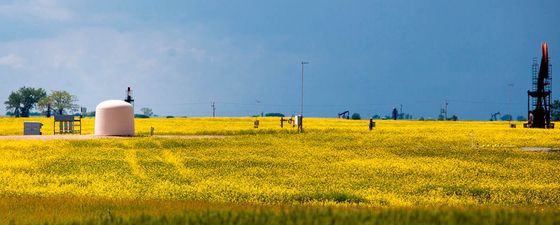With a 100 year history; capturing carbon dioxide now plays a pivotal role in the recovery of hydrocarbons.
History of Capturing Carbon Dioxide
A CO2 injection well (left) at the Weyburn field in Saskatchewan, Canada, where 31 MT of CO2 is currently injected for EOR. Photo courtesy of the Petroleum Technology Research Centre.
The idea of capturing carbon dioxide (CO2) has a surprisingly long history – nearly 100 years, in fact, since technology was developed to remove CO2 from natural gas before it could be sold. However, the concept of pumping CO2 into reservoirs to boost oil field recovery was not considered until 50 years later, when CO2 from a gas processing facility in Texas was piped to a nearby oil field and successfully injected, subsequently proving to have increased production by 5 up to 15%. Since then this process, known as CO2 EOR, has been used extensively throughout the world, and we have learnt how to technically manage the process and how it affects reservoirs – and also the economic benefits to be gleaned. The technique is not appropriate everywhere; its effectiveness is dependent on the reservoir characteristics, the chemical composition of the oil, and field history and location.
Carbon Dioxide Capturing & Hydrocarbon Production
Most CO2 EOR projects use naturally occurring CO2 extracted specifically for this purpose. There is now a lot of pressure to take this a step further and use the technique proactively as a mechanism for ensuring less CO2 is released into the atmosphere, by using waste CO2 from sources such as power plants for EOR and then storing it underground after production ceases. This is more expensive than traditional CO2 EOR as it requires additional monitoring, measuring and verification. It will need to be catered for in the design stage, as well as during and after injection, to ensure that neither the geological formations nor any abandoned wellbores leak. This is all well within the industry’s areas of expertise.
A study of 47 large oilfields in six basins spread over the world (Godec et al., 2011) estimated that the application of CO2 EOR could result in the recovery of an additional 1,070 Bbo, with associated CO2 storage potential of 320 Gt. These are significant volumes.
As has been discussed frequently, the oil and gas industry suffers from an image problem: providing a vital commodity, but considered by many to be contributing to pollution and climate change. By more actively harnessing our specialist knowledge and expertise to use waste CO2 to increase recovery while storing the gas away from the atmosphere, we would be showing the world we are listening.
Oman’s Spectacular Geology
Jane Whaley, Editor in Chief GEO ExPro Magazine
The village of Bilad Sayt, in the Al Hajar Mountains in northern Oman, can only be accessed by walking through a narrow canyon or driving down a very steep, winding road – exciting either way! The rocks towering around it are primarily the Hajar Supergroup, which are also exposed in the nearby Wadi Nakhr, commonly known as the Grand Canyon of the Middle East.
Read more…




